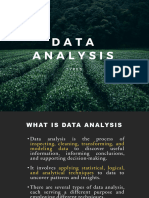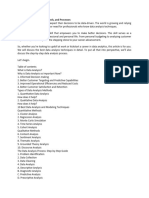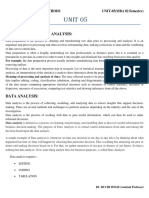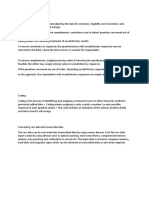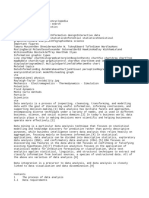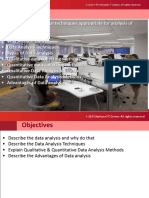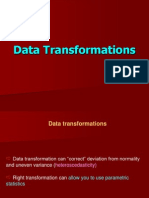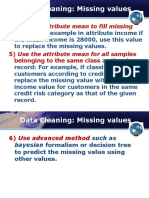TECHNIQUES OF DATA ANALYSIS
Data analysis is defined as a process of cleaning, transforming, and modeling data to discover
useful information for research and business decision-making. So, data can be evaluated using
analytical and logical reasoning to examine each component of the data provided. This analysis
is just one of the many steps to complete when conducting a research experiment. Data from
various sources is gathered, reviewed, and then analyzed to form some sort of finding or
conclusion. Different specific data analysis methods include data mining, text analytics, business
intelligence, and data visualizations. Data analysis aims to extract useful information from data
and make decisions based on the data analysis.
Data analysis aims to derive 'actionable insights, 'specific, concrete, and implementable
recommendations to guide research and business decisions. Whenever we make any decision in
our day-to-day lives, we think about what happened last time or what will happen by choosing
that particular decision. This is nothing but analyzing our past or future and making decisions
based on it. For that, we gather memories of our past or dreams of our future. So, that is nothing
but data analysis. Now, data analysis is the same thing an analyst does for business purposes. It is
a powerful process that assists in transforming raw data into actionable insights. By mastering its
techniques and tools, students or analysts can develop strong analytical skills that are highly
valued in today's data-driven world.
Organizing and thinking about data is key to understanding what the data does and does not
contain. People can approach data analysis in various ways, and it is notoriously easy to
manipulate data during the analysis phase to push certain conclusions or agendas. For this
reason, it is essential to pay attention when data analysis is presented and think critically about
the data and the conclusions drawn. Raw data can take various forms, including measurements,
survey responses, and observations. In its raw form, this information can be beneficial but
overwhelming. For the data analysis process, the raw data is ordered in a way that will be useful.
For example, survey results may be tallied so that people can see how many people answered the
survey and how people responded to specific questions. While organizing the data, trends often
emerge, which can be highlighted in the write-up of the data to ensure that readers take note.
Below are the key techniques and steps involved in data analysis:
1
�Types of Data Analysis
Before delving into the techniques of data analysis, it is essential to understand the types of data
that researchers deal with:
Quantitative Data: Numerical data that can be measured and analyzed statistically (e.g.,
income, age, temperature).
Qualitative Data: Non-numerical data that describe characteristics or attributes (e.g.,
interviews, open-ended survey responses).
Techniques of Data Analysis
Data analysis techniques can be broadly classified into qualitative and quantitative methods.
Quantitative Data Analysis Techniques
Quantitative analysis deals with numerical data and employs statistical tools for interpretation.
1. Descriptive Statistics
o Measures of Central Tendency (Mean, Median, Mode)
o Measures of Dispersion (Variance, Standard Deviation, Range)
o Frequency Distribution and Percentages
2. Inferential Statistics
o Hypothesis Testing
o Confidence Intervals
o Regression Analysis
o Correlation Analysis
o Chi-Square Test
3. Trend Analysis
o Time Series Analysis
o Moving Averages
o Forecasting Techniques
4. Machine Learning and Data Mining Techniques (Advanced)
o Clustering (K-Means, Hierarchical Clustering)
o Classification (Decision Trees, Neural Networks)
o Predictive Analytics
2
�Qualitative Data Analysis Techniques
Qualitative analysis involves non-numerical data and is often used in social sciences and
humanities research.
1. Content Analysis
o Systematic coding and categorization of text data
o Identification of themes and patterns
2. Thematic Analysis
o Extracting and interpreting themes from qualitative data
o Used in interviews and textual data
3. Narrative Analysis
o Understanding stories and experiences from qualitative data
o Used in case studies and personal narratives
4. Grounded Theory Approach
o Data-driven theory development
o Constant comparative method for pattern recognition
5. Discourse Analysis
o Study of language use in social contexts
o Used in media studies, politics, and sociology
6. Ethnographic Analysis
o Fieldwork-based research involving participant observation
o Used in anthropology and cultural studies
Tools for Data Analysis
Data analysis can be performed using various tools and software, including:
Microsoft Excel (Basic statistical functions, pivot tables)
SPSS (Statistical Package for the Social Sciences) (Advanced statistical analysis)
R Programming (Open-source statistical computing and graphics)
Python (Data science libraries such as Pandas, NumPy, Matplotlib)
NVivo (Qualitative data analysis software)
3
� Tableau (Data visualization software)
STEP IN DATA ANALYSIS
Data Collection
Definition
Data collection is gathering raw data from various sources to address a specific problem or
question. The quality and relevance of the data collected directly impact the accuracy and
reliability of the analysis.
Techniques
1. Surveys and Questionnaires:
o Used to collect structured data from a target audience.
o Example: Surveying to understand customer satisfaction.
o Tools: Google Forms, Survey Monkey, Type form.
2. Experiments:
o Controlled studies to test hypotheses or observe outcomes.
o Example: A/B testing in marketing to compare two versions of a webpage.
o Tools: Lab equipment, statistical software (e.g., R, Python).
3. Web Scraping:
o Extracting data from websites using automated tools.
o Example: Scraping product prices from e-commerce websites.
4. APIs (Application Programming Interfaces):
o Accessing data from online platforms (e.g., social media, weather services).
o Example: Using Twitter API to collect tweets for sentiment analysis.
5. Databases:
o Extracting structured data from relational (SQL) or non-relational (NoSQL)
databases.
o Example: Querying a customer database to analyze purchase history.
Considerations
Relevance: Ensure the data collected aligns with the research question.
4
� Accuracy: Verify the reliability of the data source.
Ethics: Obtain proper consent and ensure data privacy (e.g., GDPR compliance).
Data Cleaning
Definition
Data cleaning involves preparing raw data for analysis by addressing errors, inconsistencies, and
missing values. Clean data is essential for accurate analysis.
Techniques
1. Handling Missing Data:
o Imputation: Replacing missing values with statistical measures (e.g., mean,
median).
o Removal: Deleting rows or columns with excessive missing data.
o Example: Filling missing age values in a dataset with the average age.
2. Removing Duplicates:
o Identifying and removing duplicate records.
o Example: Removing repeated entries in a customer database.
3. Correcting Inconsistencies:
o Fixing typos, formatting issues, or incorrect values.
o Example: Standardizing date formats (e.g., DD/MM/YYYY to YYYY-MM-DD).
4. Standardizing Data:
o Ensuring uniformity in data (e.g., converting all text to lowercase).
o Example: Converting currency values to a single standard (e.g., USD).
Data Exploration (Exploratory Data Analysis - EDA)
Definition
EDA involves summarizing the main characteristics of a dataset, often using visual methods. It
helps identify patterns, trends, and relationships in the data.
Techniques
1. Descriptive Statistics:
5
� o Summarizing data using measures like mean, median, mode, and standard
deviation.
o Example: Calculating the average income of a population.
2. Data Visualization:
o Creating visual representations of data to identify patterns.
o Examples:
Histograms: Distribution of numerical data.
Scatter plots: Relationship between two variables.
Box plots: Identifying outliers.
3. Correlation Analysis:
o Measuring the relationship between variables.
o Example: Analyzing the correlation between study hours and exam scores.
4. Identifying Outliers:
o Detecting data points that deviate significantly from the rest.
o Example: Using box plots or Z-scores to identify outliers.
Data Transformation
Definition
Data transformation involves converting data into a suitable format for analysis. This step
ensures the data is ready for modeling.
Techniques
1. Normalization:
o Scaling data to a standard range (e.g., 0 to 1).
o Example: Normalizing test scores for comparison.
2. Encoding Categorical Variables:
o Converting categorical data into numerical format.
o Techniques:
One-hot encoding: Creating binary columns for each category.
Label encoding: Assigning a unique number to each category.
6
� o Example: Encoding gender (Male, Female) as 0 and 1.
3. Feature Engineering:
o Creating new variables from existing ones to improve model performance.
o Example: Creating a "total income" feature by summing salary and bonuses.
4. Aggregation:
o Summarizing data (e.g., daily sales to monthly sales).
o Example: Calculating monthly revenue from daily transaction data.
Data Modeling
Definition
Data modeling involves applying statistical or machine learning techniques to analyze data and
make predictions.
Techniques
1. Statistical Analysis:
o Hypothesis testing: Testing assumptions about the data (e.g., t-tests, chi-square
tests).
o Regression analysis: Modeling relationships between variables (e.g., linear
regression).
o ANOVA: Comparing means across groups.
2. Machine Learning:
o Supervised learning: Predicting outcomes using labeled data (e.g., classification,
regression).
o Unsupervised learning: Finding patterns in unlabeled data (e.g., clustering, PCA).
o Reinforcement learning: Training models to make decisions based on rewards.
3. Time Series Analysis:
o Analyzing data collected over time (e.g., stock prices, weather data).
o Techniques: ARIMA, exponential smoothing.
o
Data Interpretation
Definition
7
�Data interpretation involves drawing meaningful insights and conclusions from the analyzed
data.
Techniques
1. Identifying Trends and Patterns:
o Example: Observing a seasonal trend in sales data.
2. Making Predictions:
o Example: Predicting future sales based on historical data.
3. Testing Hypotheses:
o Example: Confirming whether a new drug is more effective than an existing one.
4. Communicating Findings:
o Example: Presenting insights to stakeholders using visualizations and reports.
Data Visualization
Definition
Data visualization is the graphical representation of data to make it easier to understand and
interpret.
Techniques
1. Charts:
o Bar charts: Comparing categories.
o Line charts: Showing trends over time.
o Pie charts: Displaying proportions.
2. Heatmaps:
o Visualizing relationships or densities in data.
o Example: Showing website traffic by hour and day.
3. Geospatial Maps:
o Displaying data on maps.
o Example: Visualizing COVID-19 cases by region.
4. Dashboards:
o Interactive displays of key metrics.
o Example: A business dashboard showing sales, revenue, and customer metrics.
8
�Reporting and Communication
Definition
Reporting involves presenting the results of data analysis to stakeholders in a clear and
actionable manner.
Techniques
1. Creating Reports:
o Written or visual summaries of findings.
o Example: A PDF report with charts and insights.
2. Presenting Findings:
o Using slideshows or dashboards.
o Example: A PowerPoint presentation for a business meeting.
3. Storytelling with Data:
o Using narratives to explain insights.
o Example: Explaining how a marketing campaign led to increased sales.
Importance of Data Analysis
Enhances decision-making based on empirical evidence.
Identifies trends, patterns, and relationships within data.
Supports policy formulation and business strategies.
Facilitates academic and scientific research.














